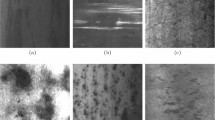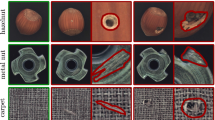Abstract
This paper set out an automatic multicategory damage detection technique using convolutional neural networks (CNN) models based on image classification and features’ extraction, to detect damages of historic structures such as: erosion, material loss, color change of the stone, and sabotage issues. The city of “Al-Salt” in Jordan was selected for the case study in this research. The best model showed an average damage detection accuracy of 95%. It was demonstrated that the proposed CNN model was significantly powerful, effective and reliable for damage detection of historic masonry buildings using features’ extraction based on imaging, and it contributed to the management and safety of historic heritage and preservation.












Similar content being viewed by others
Availability of data and material
Data transparency available.
Code availability
Custom code is available.
References
Guerra MG, Galantucci RA (2020) Standard quantification and measurement of damages through features characterization of surface imperfections on 3D models: an application on Architectural Heritages. Procedia CIRP 88:515–520. https://doi.org/10.1016/j.procir.2020.05.089
Prieto AJ, Silva A, de Brito J, Macías-Bernal JM, Alejandre FJ (2017) Multiple linear regression and fuzzy logic models applied to the functional service life prediction of cultural heritage. J Cult Herit 27:20–35. https://doi.org/10.1016/j.culher.2017.03.004
Prieto AJ, Verichev K, Carpio M (2019) Heritage, resilience and climate change: a fuzzy logic application in timber-framed masonry buildings in Valparaíso, Chile. Build Environ 174(December):2020. https://doi.org/10.1016/j.buildenv.2020.106657
Dunphy K (2021) Scholarship @ Western a systematic review of convolutional neural network-based a systematic review of convolutional neural network- based structural condition assessment techniques.
Sirohi D, Kumar N, Rana PS (2020) Convolutional neural networks for 5G-enabled intelligent transportation system: a systematic review. Comput Commun 153:459–498. https://doi.org/10.1016/j.comcom.2020.01.058.
Rai HM, Chatterjee K (2020) Detection of brain abnormality by a novel Lu-Net deep neural CNN model from MR images. Mach Learn Appl 2(June):100004. https://doi.org/10.1016/j.mlwa.2020.100004.
Palit S (2010) Studies on ozone-oxidation of dye in a bubble column reactor at different pH and different oxidation-reduction potential. Int J Environ Sci Dev 1554:341–346. https://doi.org/10.7763/ijesd.2010.v1.67
Perez H, Tah JHM, Mosavi A (2019) Deep learning for detecting building defects using convolutional neural networks. Sensors (Switzerland) 19(16). https://doi.org/10.3390/s19163556.
Zhou Q, Wang F, Zhu F (2016) Estimation of compressive strength of hollow concrete masonry prisms using artificial neural networks and adaptive neuro-fuzzy inference systems. Constr Build Mater 125:417–426. https://doi.org/10.1016/j.conbuildmat.2016.08.064
Asteris PG et al (2019) Masonry compressive strength prediction using artificial neural networks. In: Transdisciplinary multispectral modeling and cooperation for the preservation of cultural heritage, 2019, pp 200–224.
Prieto Ibáñez AJ, Macías Bernal JM, Chávez de Diego MJ, Alejandre Sánchez AJ (2016) Expert system for predicting buildings service life under ISO 31000 standard. Application in architectural heritage. J Cult Herit 18:209–218. https://doi.org/10.1016/j.culher.2015.10.006.
Vieira SM, Silva A, Sousa JMC, De Brito J, Gaspar PL (2015) Modelling the service life of rendered facades using fuzzy systems. Autom Constr 51(C):1–7. https://doi.org/10.1016/j.autcon.2014.12.011.
Zou Z, Zhao X, Zhao P, Qi F, Wang N (2019) CNN-based statistics and location estimation of missing components in routine inspection of historic buildings. J Cult Herit 38:221–230. https://doi.org/10.1016/j.culher.2019.02.002
Wang N, Zhao X, Zhao P, Zhang Y, Zou Z, Ou J (2019) Automatic damage detection of historic masonry buildings based on mobile deep learning. Autom Constr 103(March):53–66. https://doi.org/10.1016/j.autcon.2019.03.003
Wang N, Zhao X, Zou Z, Zhao P, Qi F (2018) Autonomous damage segmentation and measurement of glazedtiles in historic buildings via deep learning, 2018.
Heidari M, Torabi-Kaveh M, Chastre C, Ludovico-Marques M, Mohseni H, Akefi H (2017) Determination of weathering degree of the Persepolis stone under laboratory and natural conditions using fuzzy inference system. Constr Build Mater 145:28–41. https://doi.org/10.1016/j.conbuildmat.2017.03.230
Monna F et al (2020) Machine learning for rapid mapping of archaeological structures made of dry stones—example of burial monuments from the Khirgisuur culture, Mongolia. J Cult Herit 43:118–128. https://doi.org/10.1016/j.culher.2020.01.002
Valero E, Forster A, Bosché F, Hyslop E, Wilson L, Turmel A (2019) Automated defect detection and classification in ashlar masonry walls using machine learning. Autom Constr 106(May):102846. https://doi.org/10.1016/j.autcon.2019.102846.
Sharma Teena, Agrawal Pooja, Verma Nishchal (2019) Detection of dust deposition using convolutional neural network for heritage images. https://doi.org/10.1007/978-981-13-1135-2_27.
Funding
No funding.
Author information
Authors and Affiliations
Corresponding author
Ethics declarations
Conflict of interest
The authors have no financial, commercial, legal, or professional relationship with other organizations, or with the people working with them, that could influence this research.
Ethics approval
All procedures performed in studies involving human participants were in accordance with the ethical standards of the institutional and/or national research committee and with the 1964 Helsinki declaration and its later amendments or comparable ethical standards.
Consent to participate
The authors voluntarily agree to participate in this research.
Consent for publication
The author gives the publisher license of the copyright which provides the publisher with an exclusive right to publish and sell the research findings in all languages, in whole or in part.
Additional information
Publisher's Note
Springer Nature remains neutral with regard to jurisdictional claims in published maps and institutional affiliations.
Rights and permissions
About this article
Cite this article
Samhouri, M., Al-Arabiat, L. & Al-Atrash, F. Prediction and measurement of damage to architectural heritages facades using convolutional neural networks. Neural Comput & Applic 34, 18125–18141 (2022). https://doi.org/10.1007/s00521-022-07461-5
Received:
Accepted:
Published:
Issue Date:
DOI: https://doi.org/10.1007/s00521-022-07461-5




